AMD Radeon RX 6950 XT
AMD Radeon RX 6950 XT: Two minute review
AMD should have led with the AMD Radeon RX 6950 XT.
After a year and a half since AMD launched this generation's RDNA 2 graphics cards, and almost two years after Nvidia launched its first consumer Ampere cards, AMD has come out with a card that epitomizes everything AMD is known and respected for. It's just a shame that it's last call on this generation of graphics cards, and the RX 6950 XT likely won't get the love it really deserved.
The RX 6950 XT is the first graphics card from Team Red to pose an actually serious challenge to the Nvidia RTX 3090's gaming performance, and even though some inconsistencies inevitably hold it back from going a full twelve rounds against Nvidia's best, it's the kind of fighter that you find yourself cheering for anyway.
What is so appealing about the AMD Radeon RX 6950 XT is that it is simply one of the best graphics cards – if not the best – in the premium tier when measuring its price to its performance. AMD has always been known for offering great cards at a great price, and what's amazing about the RX 6950 XT is that AMD manages to bring that same philosophy into the premium tier of the graphics card market.
Cards at this level are all about performance and they normally have prices to match, but the RX 6950 XT shows that even the most exclusive clubs can have an item or two on the value menu.
As such, it is a great option for gamers out there who can afford a premium card, but aren't actually giant, human-shaped, walking piles of money – it least it would be, if RDNA 3 wasn't right around the corner. AMD's next-gen graphics cards are likely to make some major advances in terms of ray tracing and hardware-assisted upscaling tech that should blow the current generation of AMD cards out of the water, so buying anything premium from this generation right now is iffy at best.
It's entirely possible that an AMD Radeon RX 7800 XT could have comparable performance to the RX 6950 XT, and it will likely be cheaper, so the potential value of this card is somewhat wasted with so late an entry into the market. Again, it's a shame, because this card has a lot going for it, at least on the gaming front.
If you're not a gamer though, there really isn't a whole lot for you here. While the RX 6950 XT is the best AMD graphics card to hit the market, its creative workload performance still lags considerably behind the best Nvidia GeForce graphics cards, and without Tensor cores, the RX 6950 XT simply isn't up for the task of intense machine learning models and other similar research work that makes Nvidia RTX cards so prized.
All that said, this was always meant to be a gamer's graphics card, and for the price you're paying, the AMD Radeon RX 6950 XT might be that rare premium PC component that manages to deliver outstanding value in a market where such an idea is almost entirely alien. But if you can wait until RDNA 3 launches, it might be worth seeing what AMD's next-gen cards offer before plopping down a lot of money on a card that could be quickly overshadowed before the year is out.
AMD Radeon RX 6950 XT: Price and availability
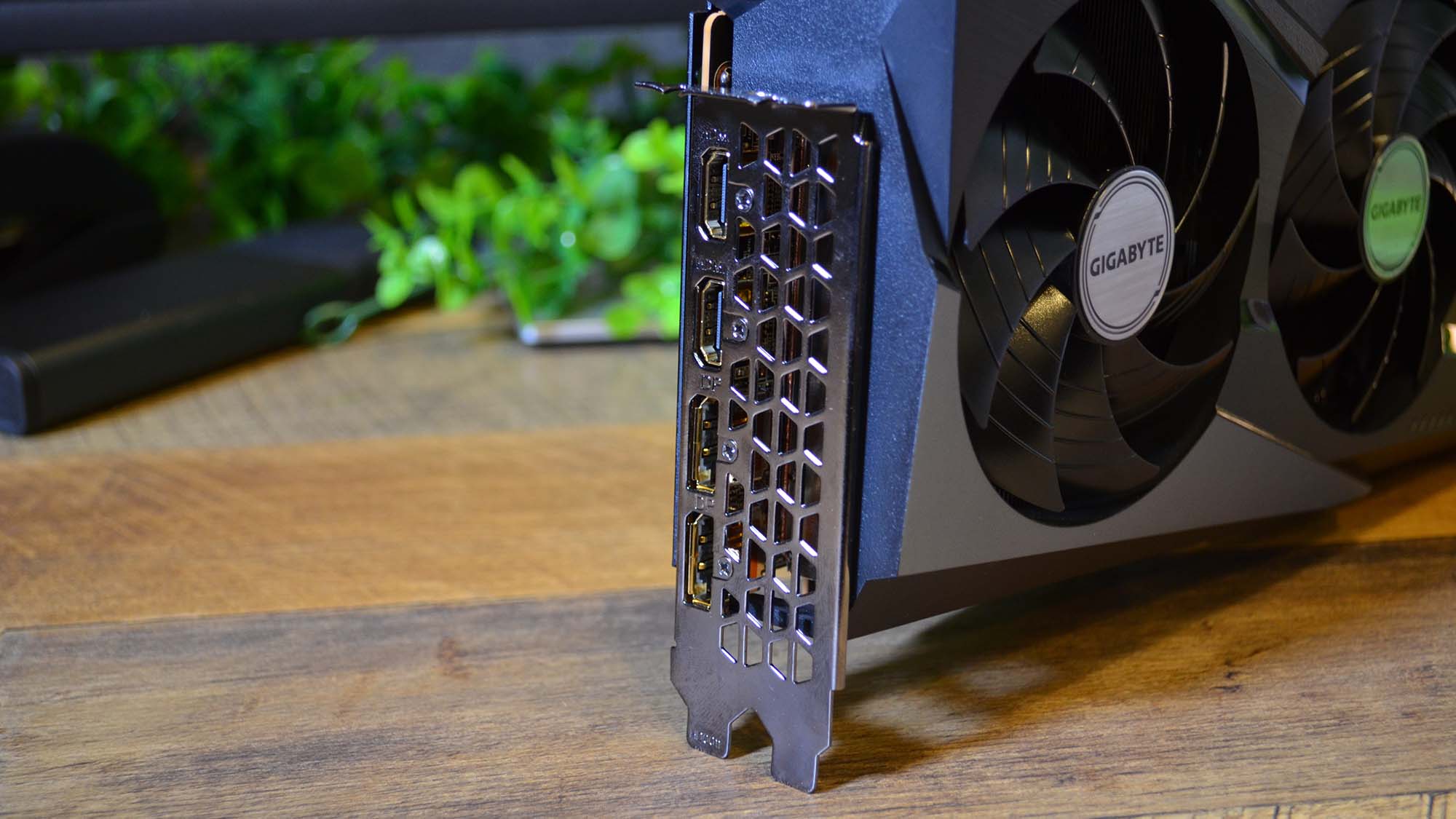
- How much is it? MSRP listed at $1,099 (about £880, AU$1,580), $1,299 as reviewed
- When is it out? It is available now
- Where can you get it? You can buy in the US, UK, and Australia
The AMD Radeon RX 6950 XT we reviewed is the Gigabyte RX 6950 XT Gaming OC version, rather than an AMD reference card, so it's a bit more expensive than AMD's $1,099 (about £880, AU$1,580) MSRP.
The Gigabyte RX 6950 XT Gaming OC card retails for $1,299 (about £1,039 / AU$1,870), which is still $200 (about £160 / AU$290) cheaper than Nvidia's RTX 3090 Founders Edition card, and $300 (about £240 / AU$430) cheaper than the Gigabyte GeForce RTX 3090 Gaming OC card.
AMD's MSRP for the RX 6950 XT is also $100 (about £80 / AU$145) less than the Nvidia GeForce RTX 3080 Ti, even though the 3080 Ti is a much more comparable card to the RX 6950 XT by the numbers in most cases.
It's also worth noting that AMD cards are generally not as heavily bought for mining or by profiteers on resale sites, so they've generally seen better availability than RTX 30-series cards and so might be easier to find in most cases.
- Value: 4/5
AMD Radeon RX 6950 XT: Design and chipset
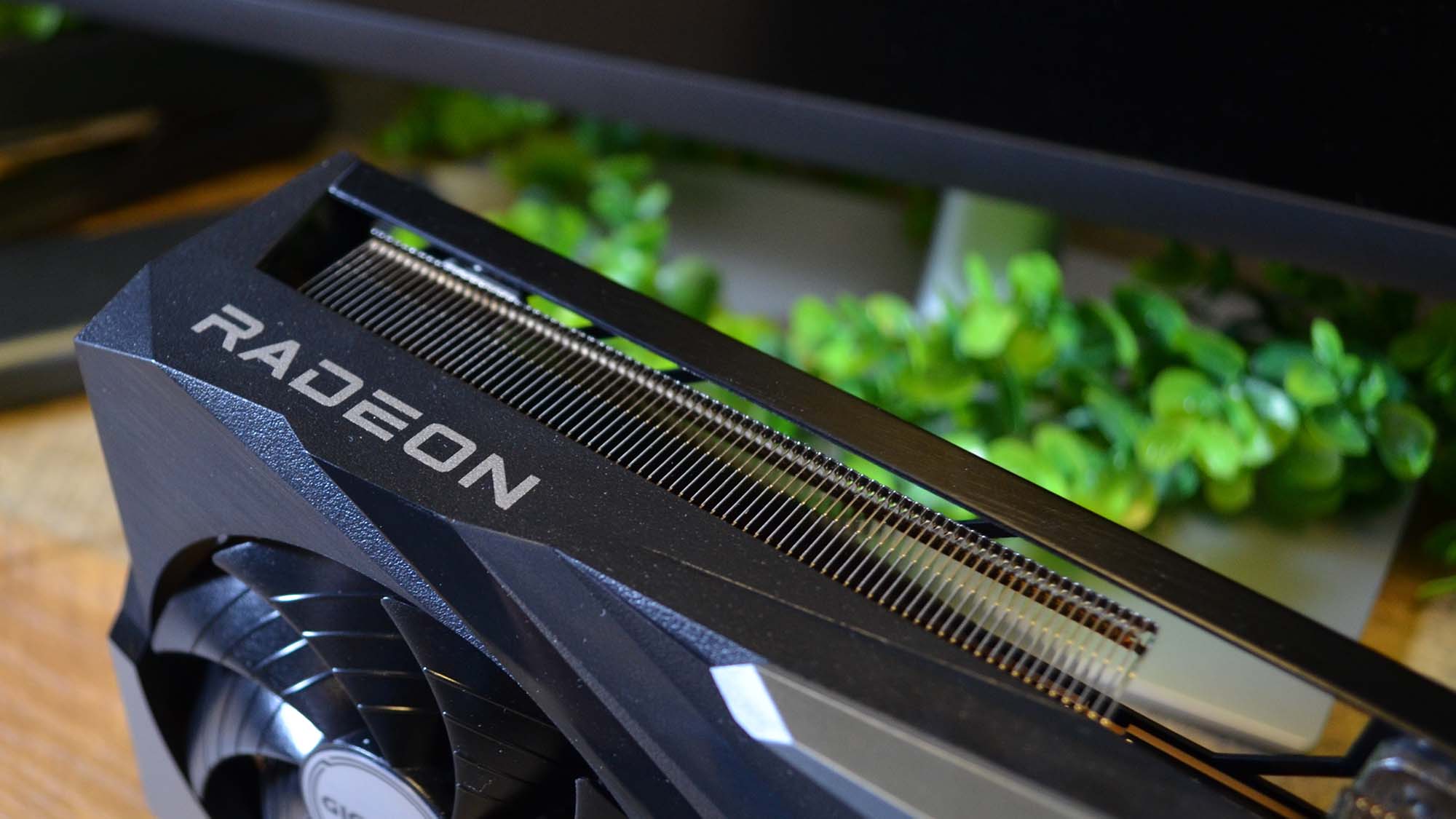
- On-board Dual BIOS switch for OC and Silent modes
- 16.7 million RGB color options for Gigabyte logo on card
- Faster GPU and memory clocks
The Gigabyte RX 6950 XT Gaming OC card we reviewed is a pretty good looking card that you won't be embarassed to show off in your build, and it sure as hell looks more attractive than the AMD reference card design for the RDNA 2 cards.
Sporting a silver and dark gray colorway, the Gigabyte card features a three-alternating-fan cooling solution where the middle fan spins counterwise to the two fans on either side of it. This is designed to make for less turbulent air flow through the card to help keep things cool, and it does appear to take 5°C to 10°C off the max temperature in our tests compared to the RTX 3090 Ti and RTX 3080. But that isn't so much of a difference that other conditions might have played a larger role than a counterclockwise spinning fan blade. If nothing else, it looks cool if you stop to notice it at any point.
GPU: Navi21
Stream Processors: 5,120
Ray Accelerators: 80
Power Draw (TGP): 335W
Base Clock: 1,925 MHz
Boost Clock: 2,324 MHz
VRAM: 16GB GDDR6
Memory Speed: 1,800MHz
Memory Bus: 256-bit
Memory Bandwith: 576.0 GB/s
Card Interface: PCIe 4.0
Outputs: 2 x HDMI 2.1, 2 x DisplayPort 1.4a
Power Connector: 3 x 8-pin
Recommended PSU: 850W
Chances are you won't really see it though, but that's ok because Gigabyte's Aorus Fusion 2.0 will let you program 16.7 million different color options into the Gigabyte logo along the visible edge, including several different patterns like color wave, color pulse, and more, that adds some additional RGB flair to your build.
There is also a attractive looking backplate to the card that doesn't just protect the sensitive connections on the PCB, but the brushed metal design has an almost space-station-y feel to it that is an excellent complement to a Gigabyte Aorus motherboard.
Along the edge of that backplate, you'll also find a dual BIOS switch that can flip the card from OC to Silent mode, with the former pushing performance while the latter is designed for quieter operation.
Finally, this card needs a lot of power, but it blessedly doesn't come with Nvidia's funky new connectors that require an adapter to convert from your standard 8-pin to a 12-pin one. The RX 6950 XT will still require three available 8-pin connectors though.
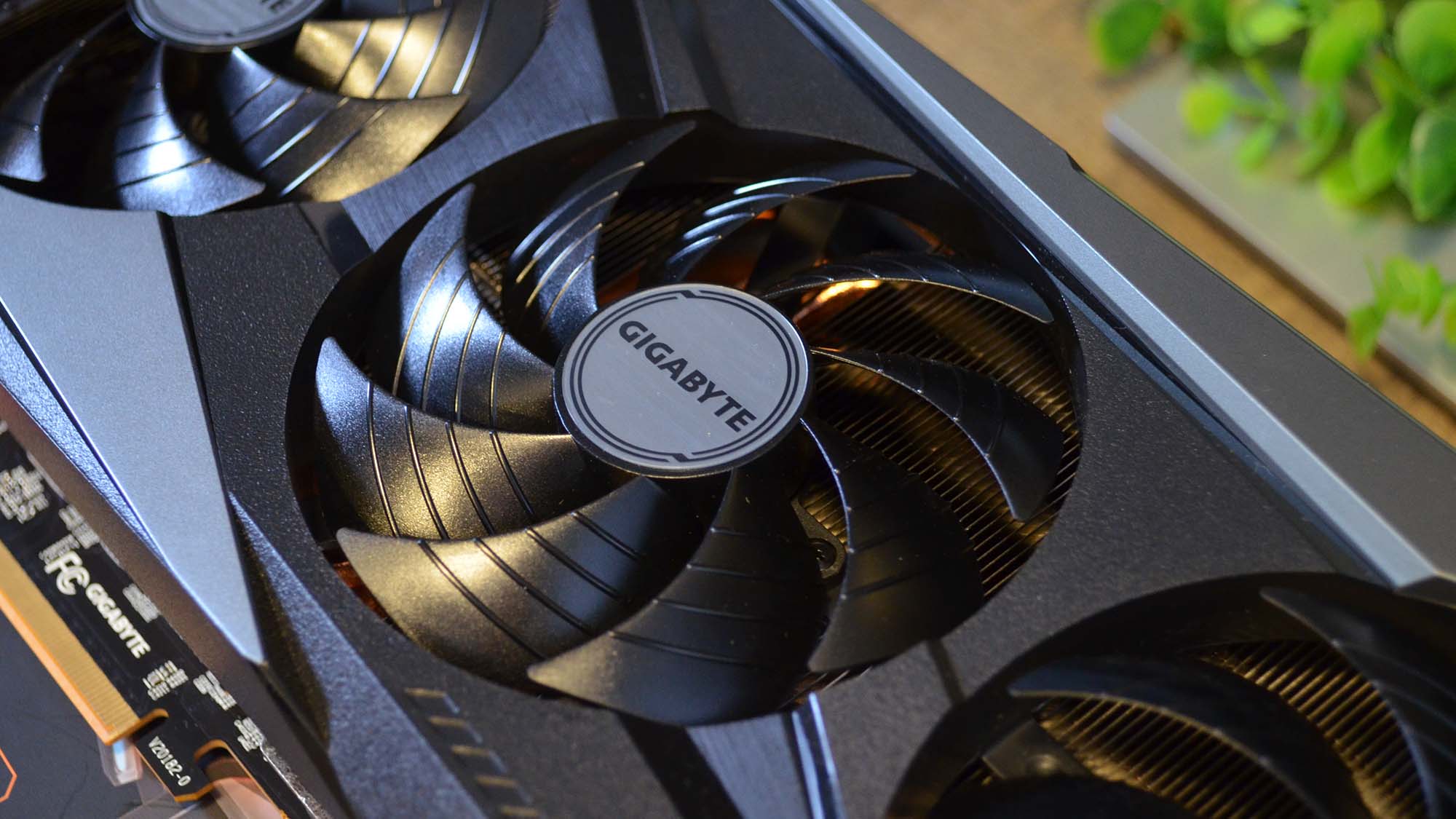
On the inside, the Gigabyte RX 6950 XT is powered by the same Navi21 GPU found in the Radeon RX 6900 XT, though with some faster clock speeds for both the GPU and the 16GB of GDDR6 memory.
The RX 6900 XT, for example, features a base clock of 1,825 MHz and a boost of 2,250 MHz, compared to the RX 6950 XT's 1,925 MHz and 2,324 MHz, respectively, which is a bit over 3% to 5% faster.
In terms of memory, the VRAM on the RX 6950 XT is also a bit faster at 2,250MHz, compared to the RX 6900 XT's 2,000MHz. With the amount of VRAM and the same 256-bit memory bus, this extra speed might not seem like a lot, but it does mean that the card has almost 13% more memory bandwidth than the RX 6900 XT, 576GB/s to 512GB/s, respectively.
The RX 6950 XT has the same number of stream processors as the RX 6900 XT (5,120), as well as the same number of Ray Accelerators (80). With its faster clocks and an additional 35W of TGP as the RX 6900 XT (325W to 300W, respectively), the RX 6950 XT is simply able to do more with the hardware it has.
- Design: 3.5/5
AMD Radeon RX 6950 XT: Performance
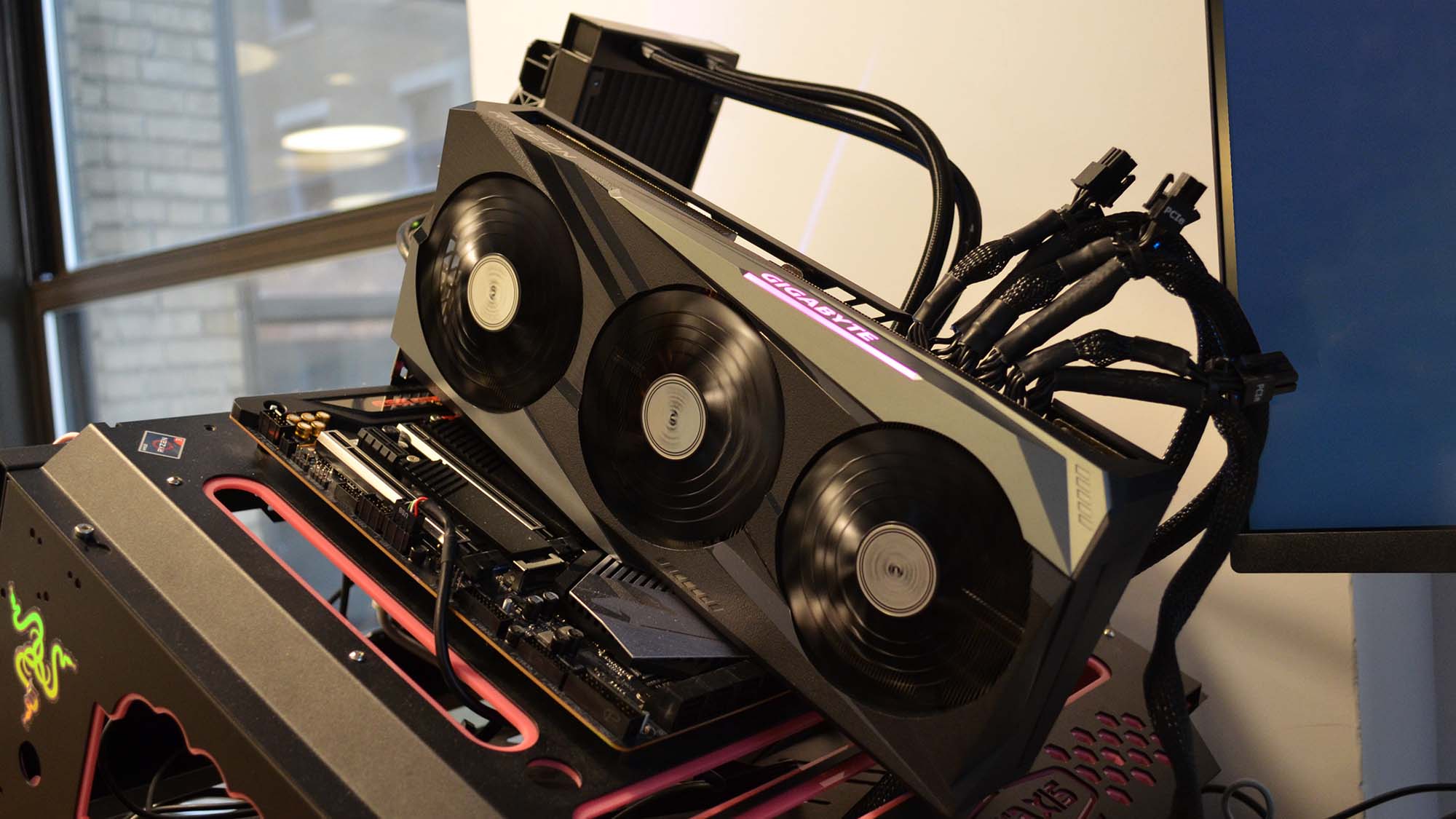
- Excellent RTX 3090-level performance (most of the time)
- Creative workloads falter
The AMD Radeon RX 6950 XT is unquestionably the best video card AMD has ever put out, and while it's not exactly the equal of the RTX 3090 (or the RTX 3080 Ti, in some cases), it's still more than enough performance to play the best PC games on ultra settings with some ray tracing and get playable and even enjoyable 4K gaming with the help of AMD FSR.
This is the system we used to test the AMD Radeon RX 6950 XT:
CPU: AMD Ryzen 7 5800X3D
CPU Cooler: Corsair iCue H150i Elite Capellix 360mm AIO
RAM: ffCorsair Vengeance LED DDR4-3200
Motherboard: Gigabyte Aorus Master X570 (BIOS F36c)
SSD: Samsung 980 Pro 1TB NVMe M.2 SSD
Power Supply: Corsair AX1000
Case: Praxis Wetbench
FSR support is still rolling out, so you may still need to make adjustments to your settings to hit the top of the parabolic curve where graphics quality and 60 fps line up.
But that's the case even with the RTX 3090 Ti with DLSS on, which only just barely hits 60 fps (ocassionally) in Cyberpunk 2077's benchmark at 4K with the Ultra Ray Tracing graphics preset. And, even then, that's its max frame rate, its average is in the high 40s, while without any upscaling, the RTX 3090 Ti only hits 24 fps on those settings.
The RX 6950 XT, meanwhile, only maxes out in the high 30s with FSR on, though it's average is about 29 fps. Without any upscaling support, the RX 6950 XT creaks in with 13 fps on these settings.
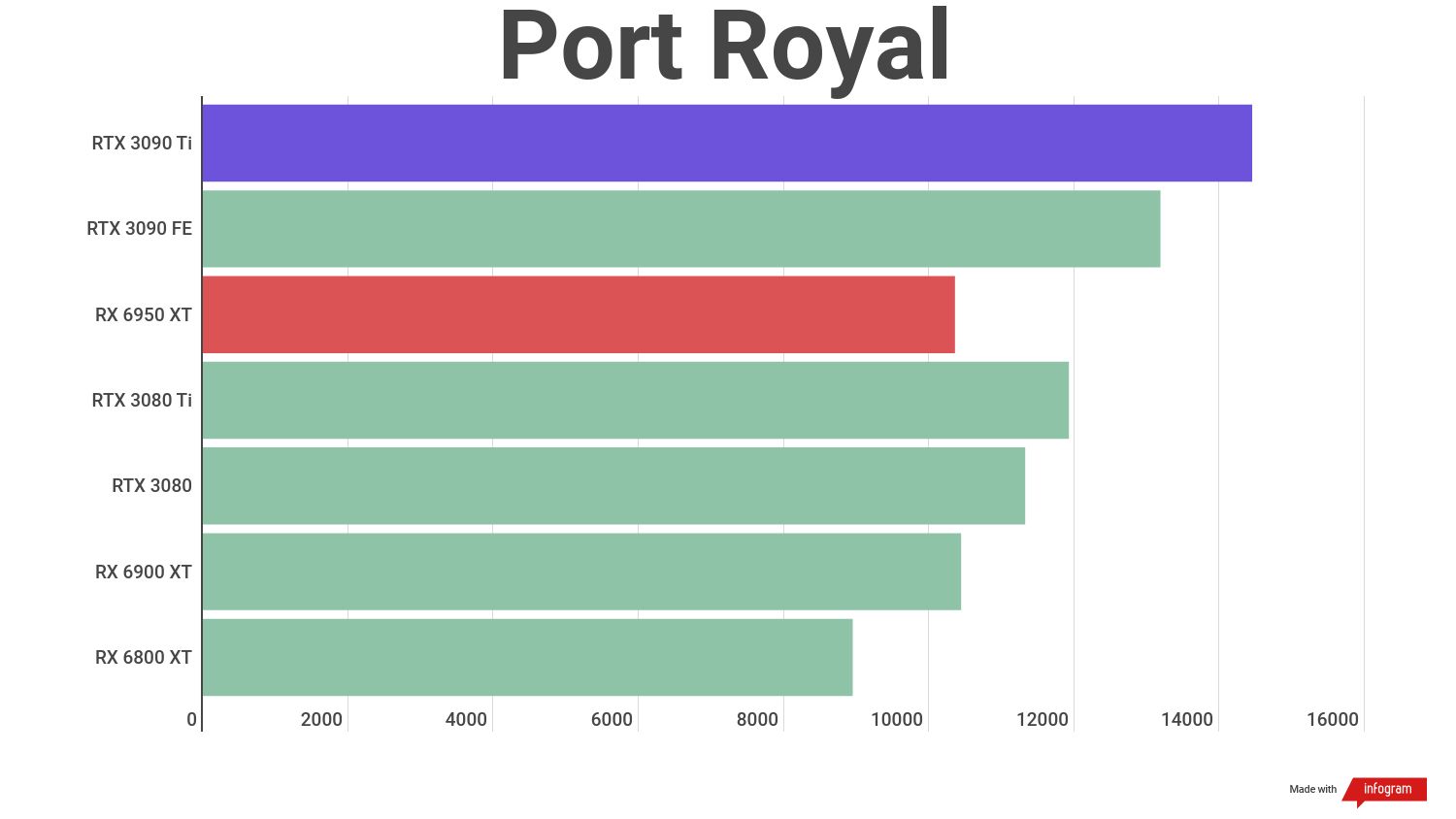
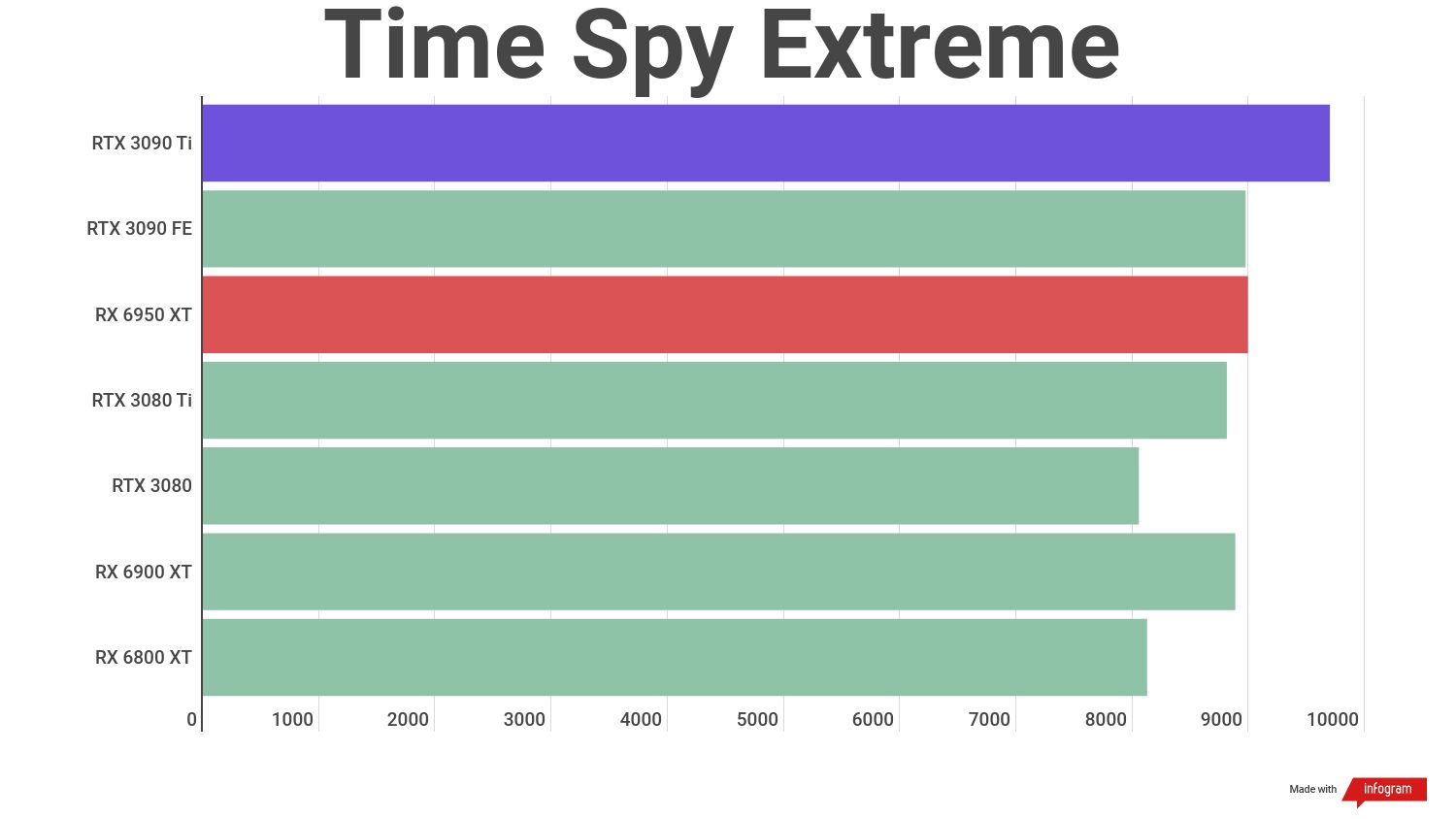
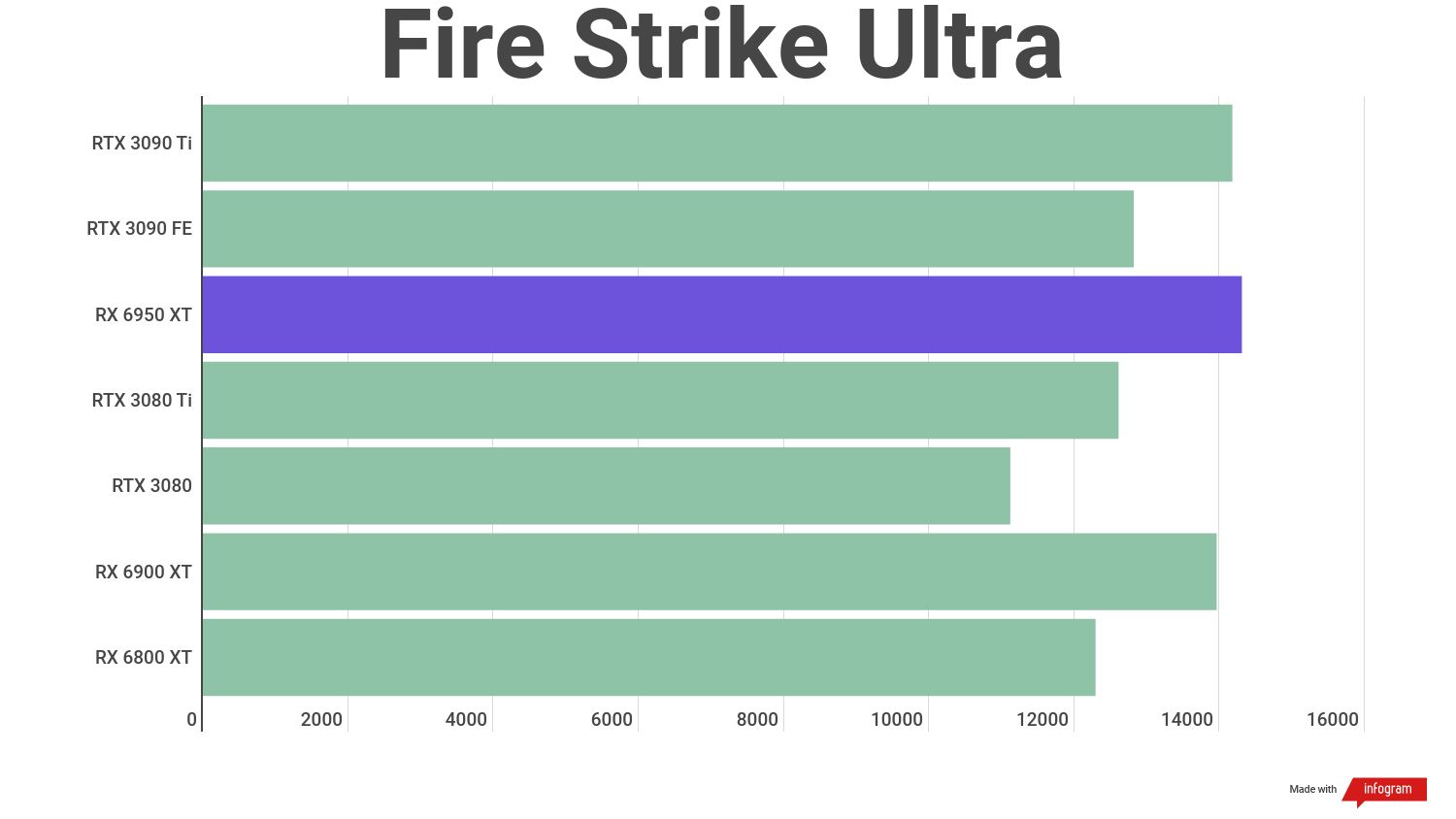
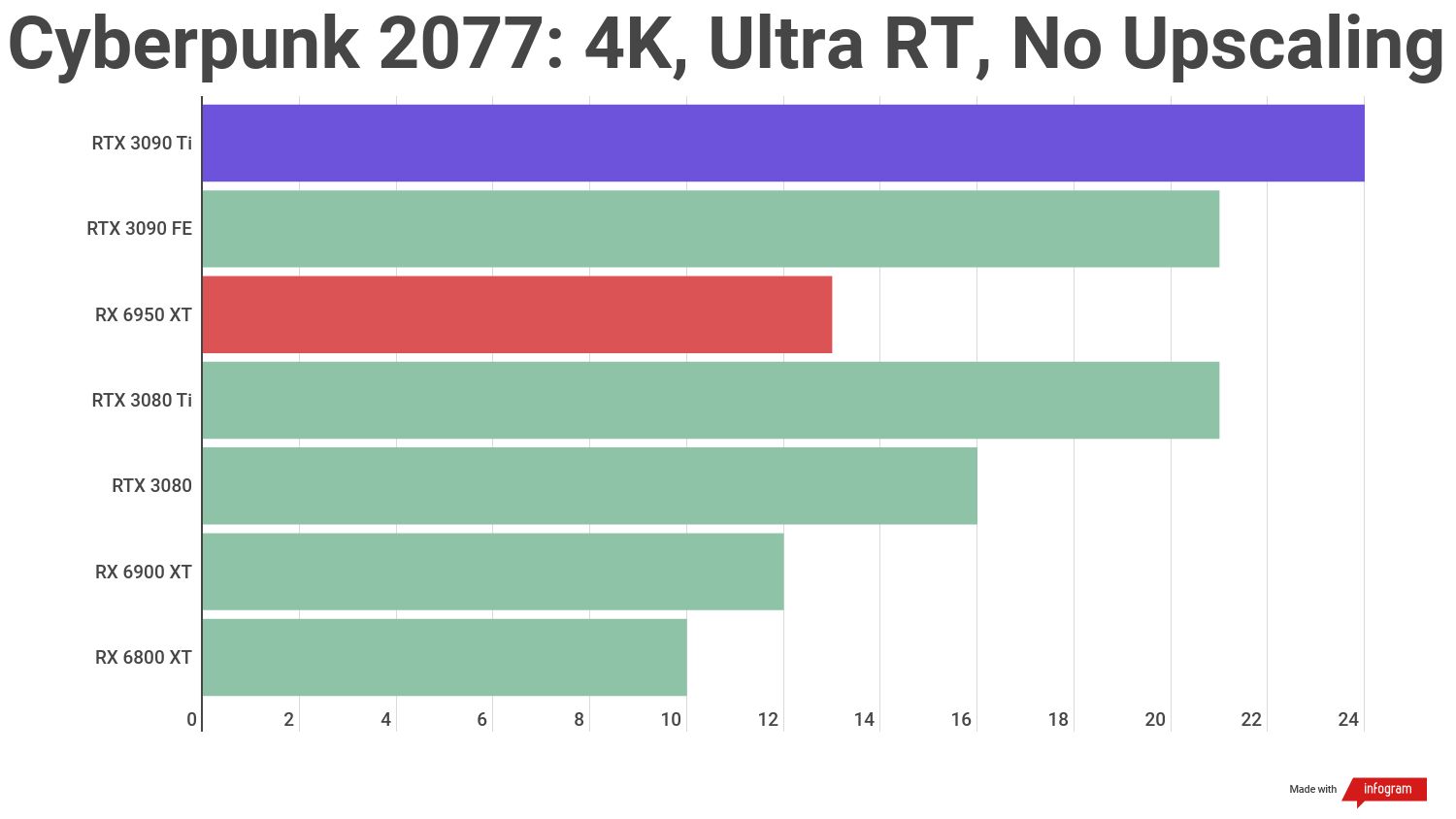
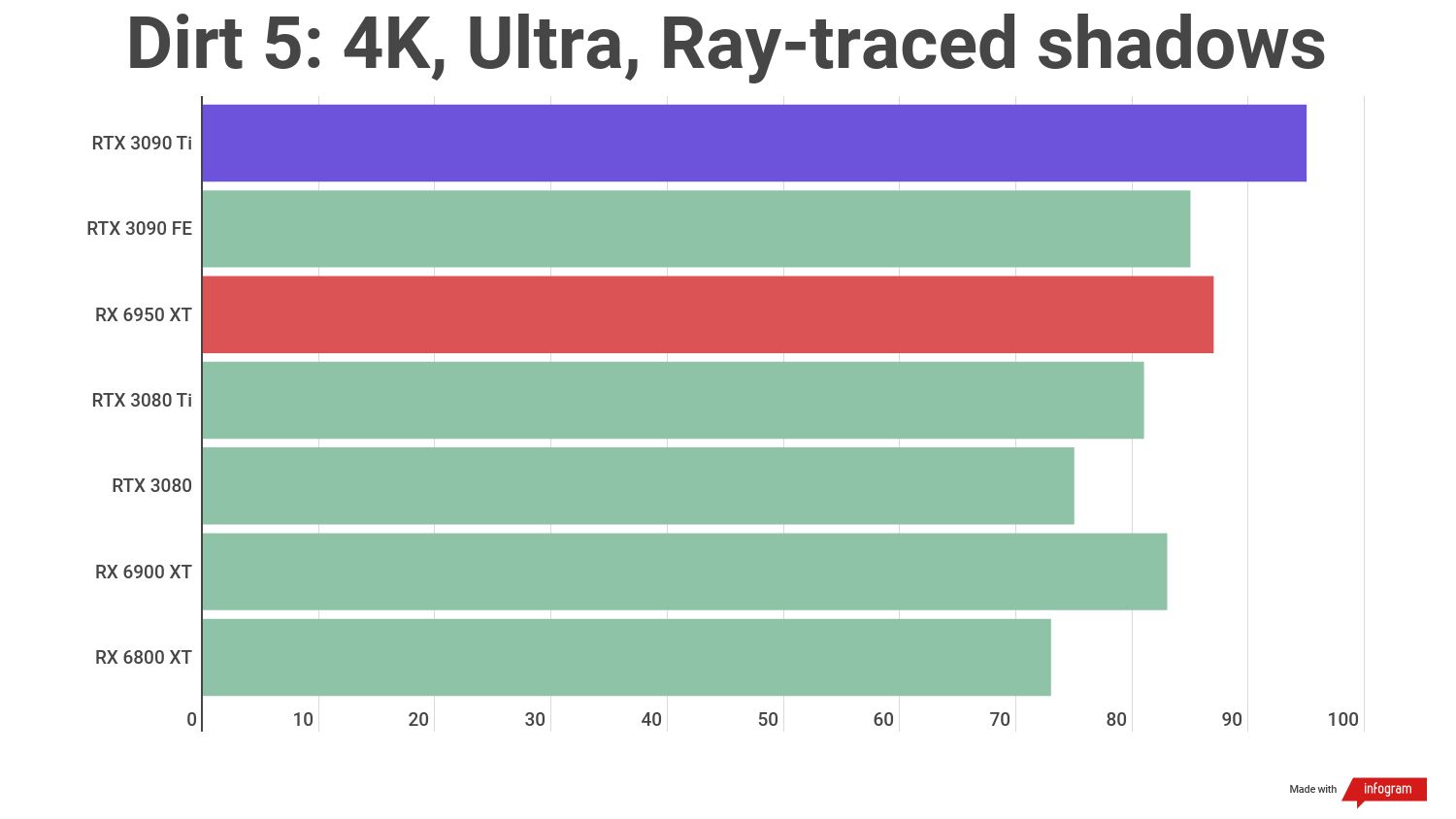
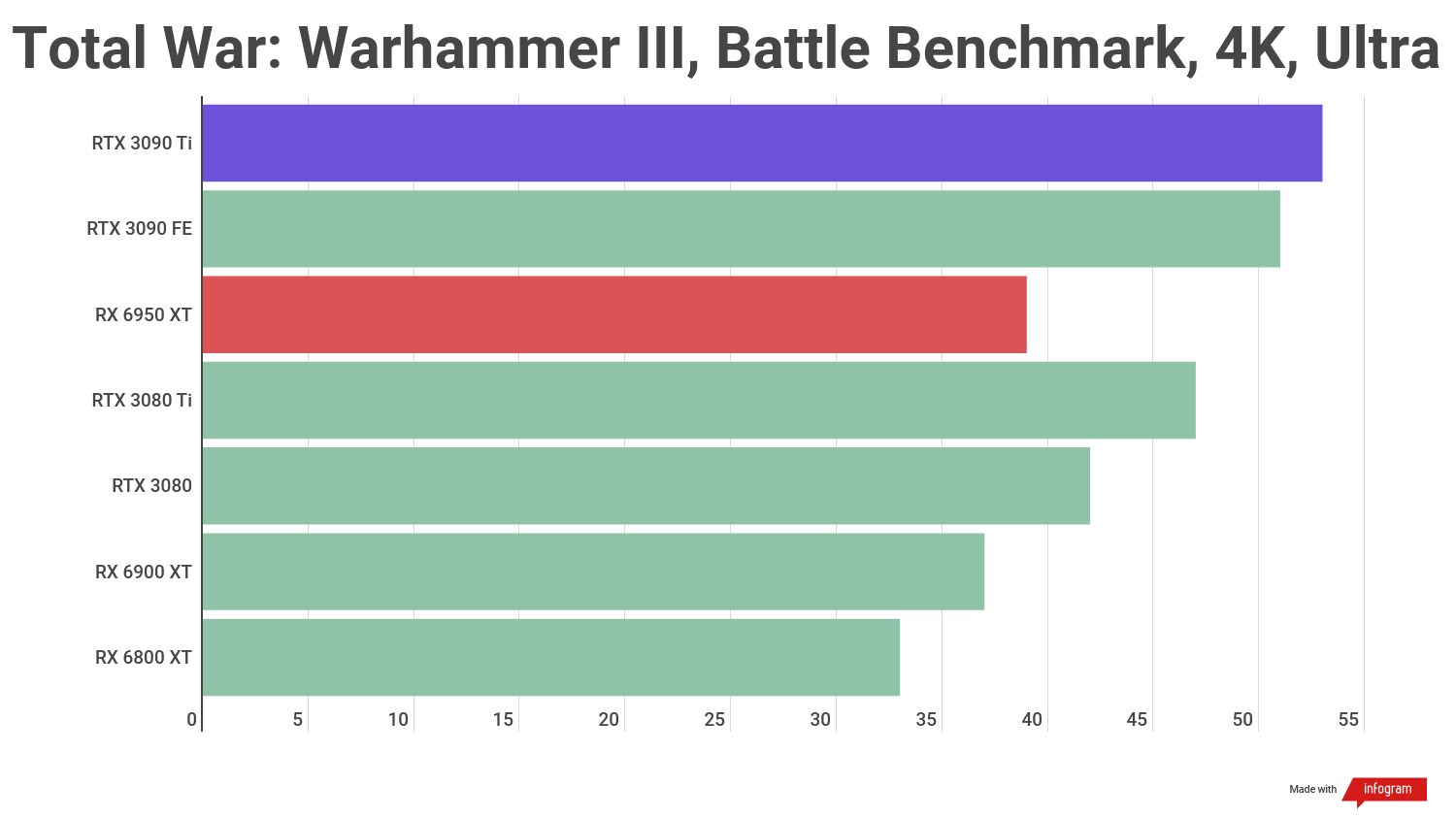
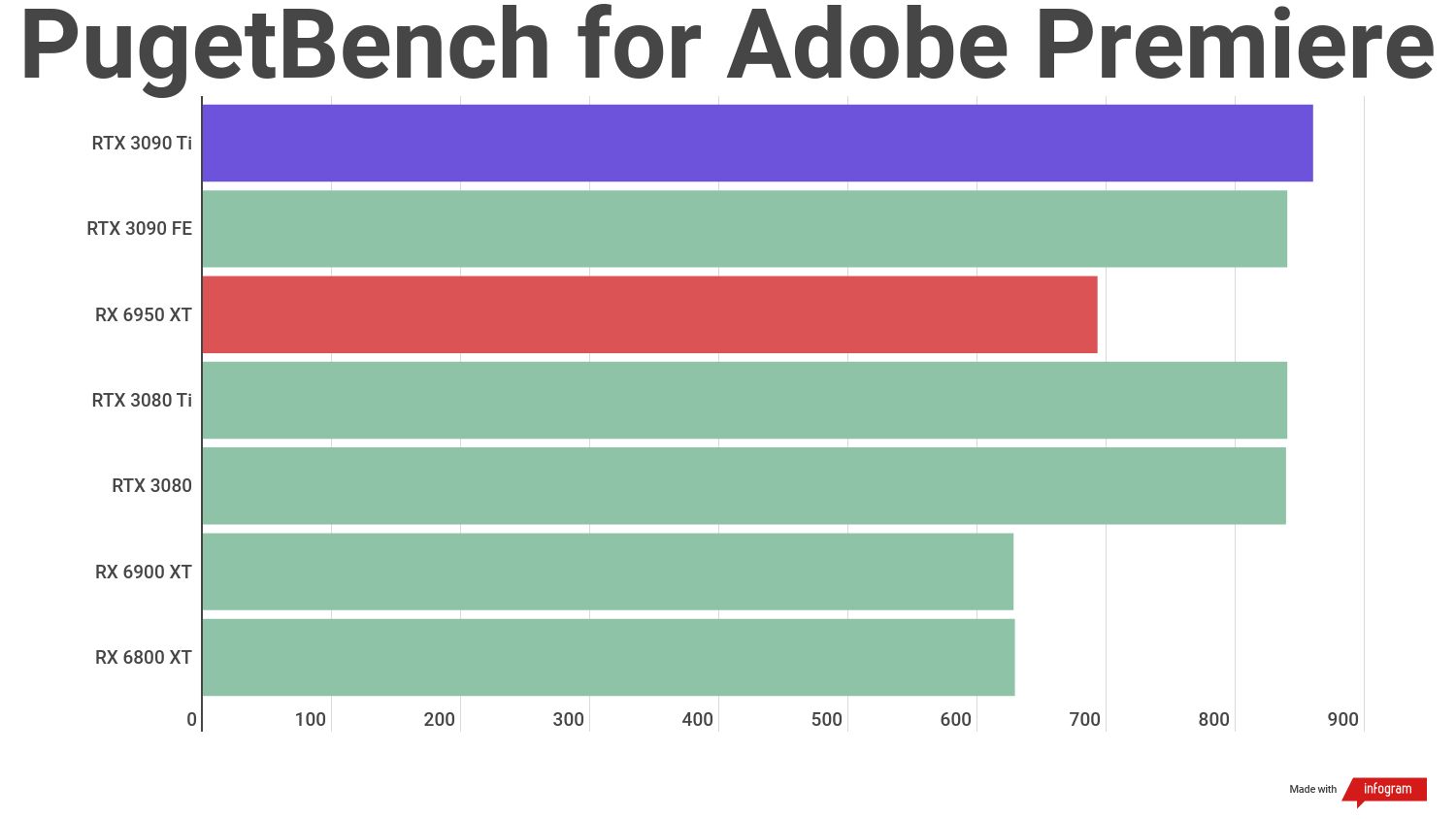
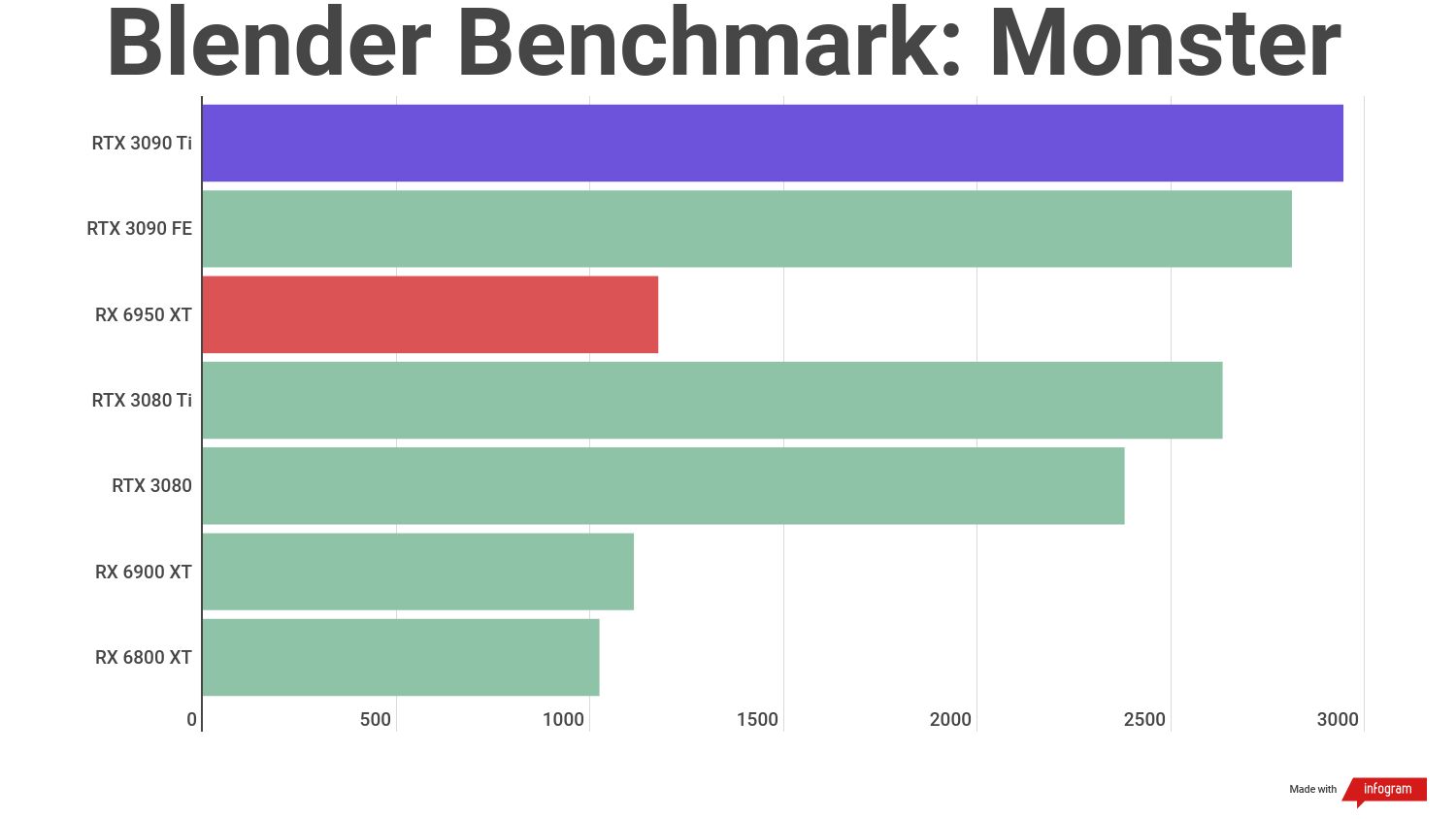
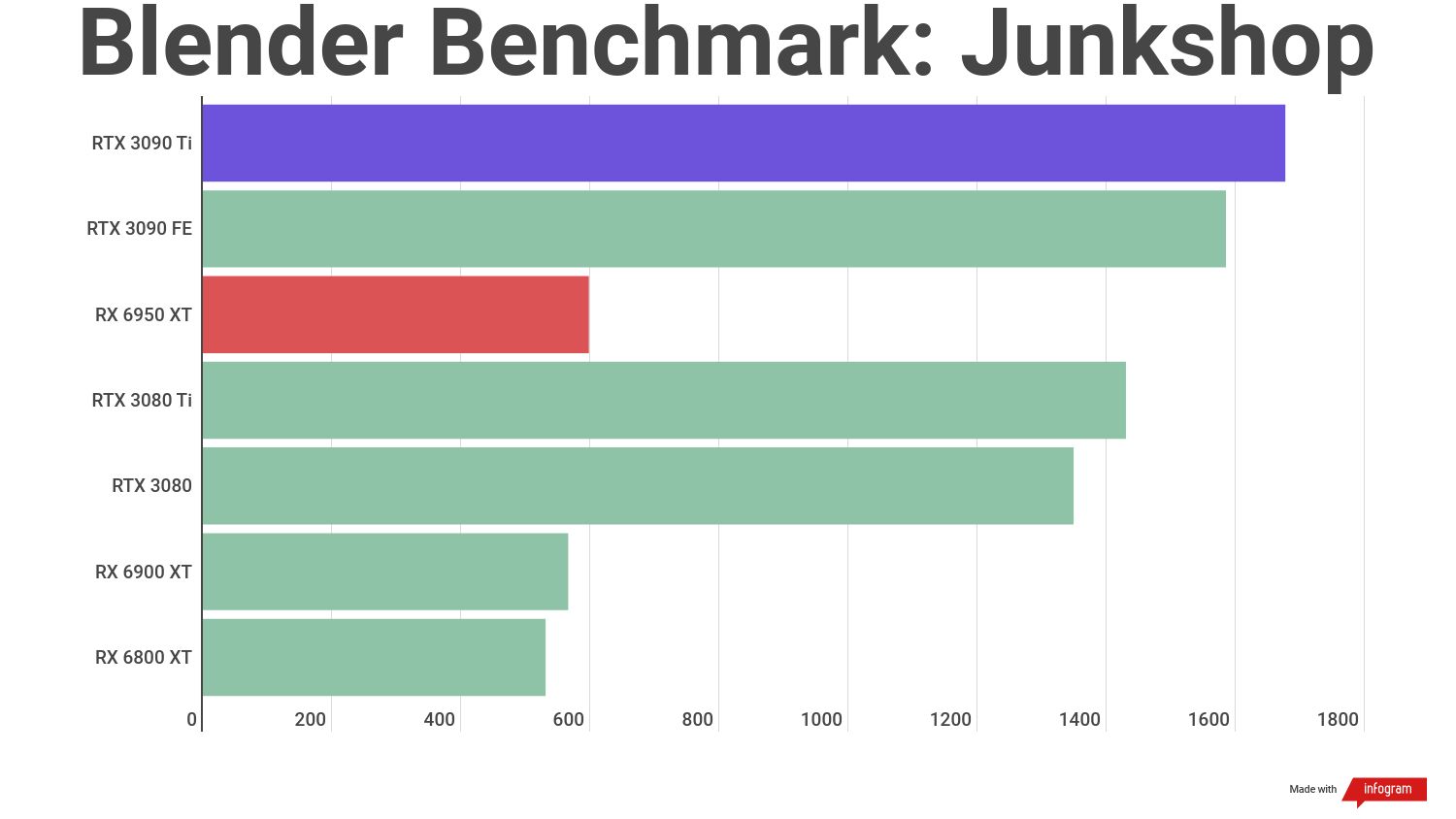
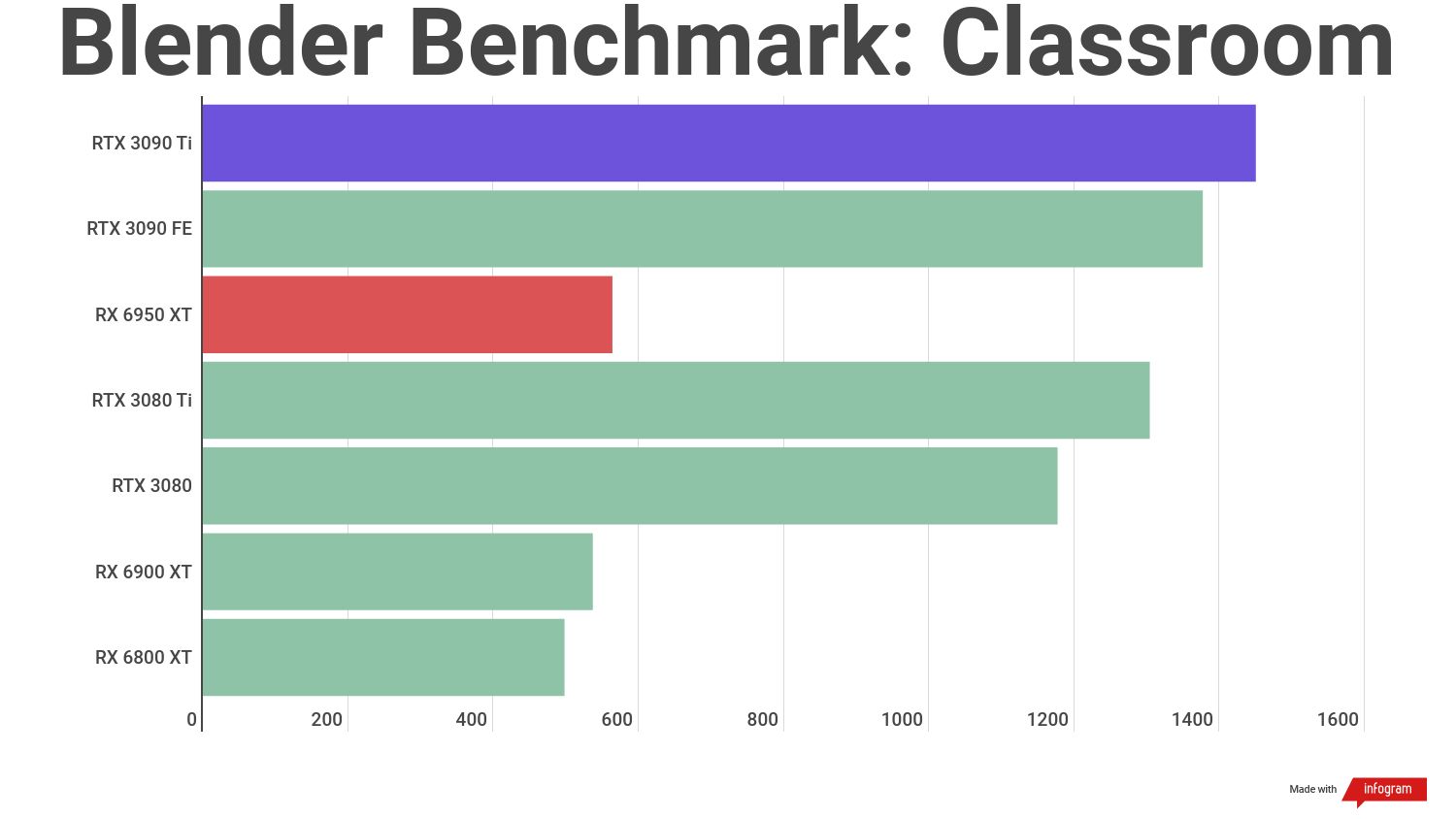
In nearly all of our benchmarks, the RX 6950 XT falls short of the RTX 3090 and Nvidia GeForce RTX 3080 Ti, and even the Nvidia GeForce RTX 3080, depending on the test. But where the RX 6950 XT falters, it's not completely bowled over, and its greatest weakness is when ray tracing is being pushed to the max.
Nvidia cards are simply better at ray tracing since their ray tracing cores are just a more mature graphics architecture at this stage than AMD's first generation Ray Accelerators introduced with AMD RDNA 2. The RX 6950 XT's rasterization performance is still just as good or better than the RTX 3080 Ti and RTX 3090's, with the latest AMD card beating even the RTX 3090 Ti in 3DMark's Fire Strike Ultra.
So while the Nvidia RTX cards are definitely the reigning champs at ray tracing, in many cases you simply won't be using ray tracing, since even on the top-tier Nvidia GPUs, you're still looking at a 4K slideshow without upscaling tech like DLSS and FSR, and not every game has implemented those technologies yet. In the case of most games you will be playing for the next couple of years, you're much more likely to need to lean on rasterization performance as you always have.
Ray tracing and upscaling tech just isn't fully here yet for it to be a blowout, and once you've enjoyed the show with ray tracing for a bit and you actually want to do some 4K gaming at 60fps, the RX 6950 XT becomes a lot more competitive, especially if you're willing to tweak some settings where appropriate, though not on every game out there.
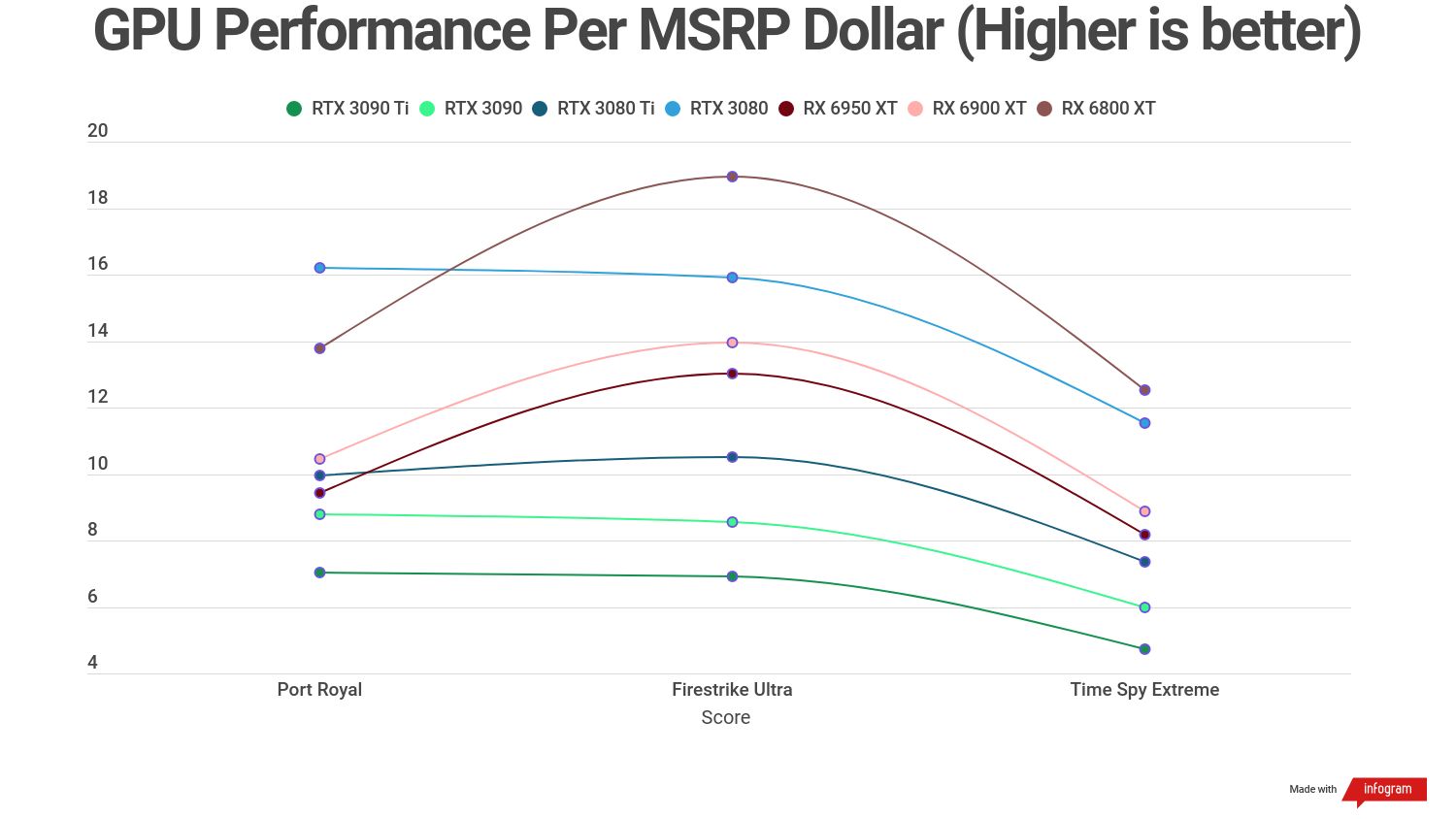
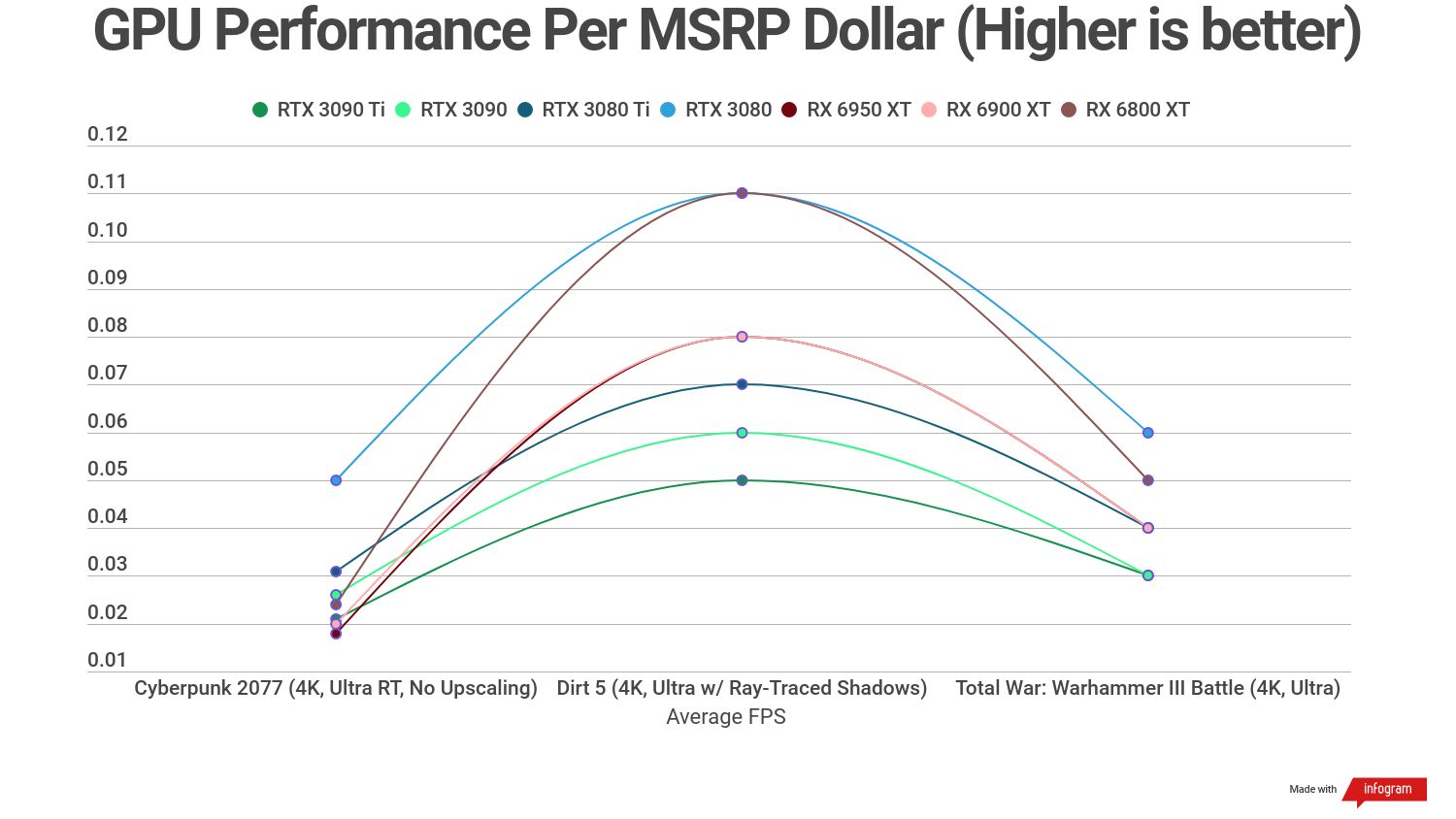
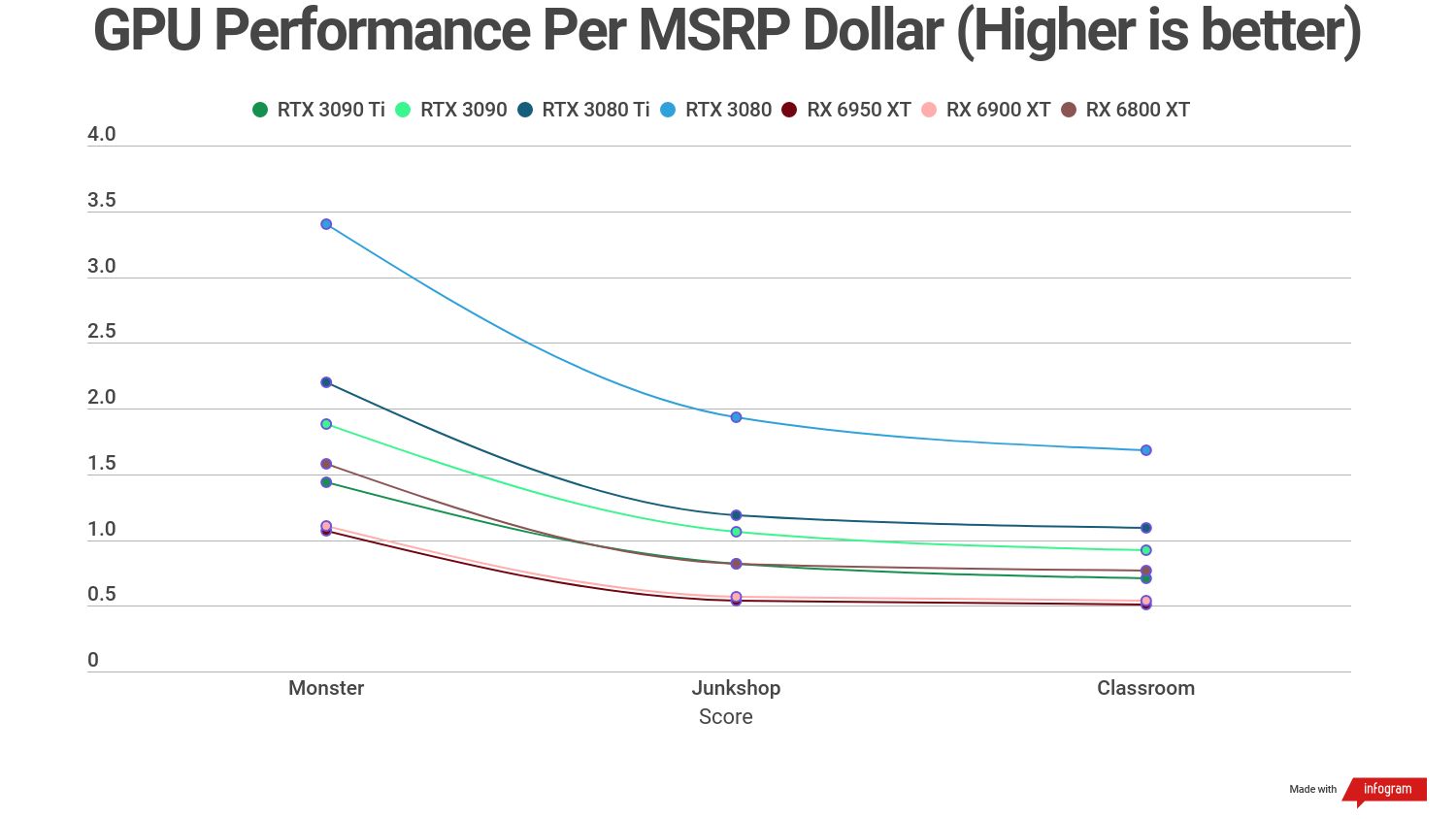
The most important thing to say about the RX 6950 XT though is that for a lot of people, the idea of owning an RTX 3090 or RTX 3090 Ti is a pipe dream at their MSRP – even if it weren't for the silicon shortage, dastardly eBay and StockX profiteers, and the crypto bubble of 2020 - 2022 mucking things up even further.
At $1,099, the RX 6950 XT is roughly 27% cheaper than the RTX 3090 Founders Edition, and it's nearly half the price of the RTX 3090 Ti. It's even cheaper than the RTX 3080 Ti, and its gaming performance is very competitive against these top three RTX cards when you consider how much performance you get for every dollar spent on the card.
And we do want to stress that this is a gamer's graphics card, without a doubt. It does better than every other AMD card on our creative benchmarks, but it still way behind where even the RTX 3060 Ti is across Blender's three benchmark tests.
In fact, the RX 6950 XT only starts to beat out Nvidia cards in Blender starting at the RTX 3060, and even then it's just barely in only one of the three tests. Similarly, it's Adobe Premiere performance lags about 50 points behind the RTX 3060, and the RTX 3060 is about a third of the price of the RX 6950 XT. If you're a creative, you have a lot better options out there that will offer you a much better value for the workflows that you need.
All that said, while we can't say it's the best graphics card out there, the AMD Radeon RX 6950 XT is pretty damned great if you're looking for a gaming graphics card, especially since it can give you a taste of really premium graphics if you're priced out of the RTX 3090 and RTX 3090 Ti. As this generation of graphics cards winds down ahead of Nvidia Lovelace and AMD RDNA 3, the AMD Radeon RX 6950 XT is a great card to close it out with. And who knows? You might even be able to find this one in stock someday.
- Performance: 4/5
Should I buy an AMD Radeon RX 6950 XT?
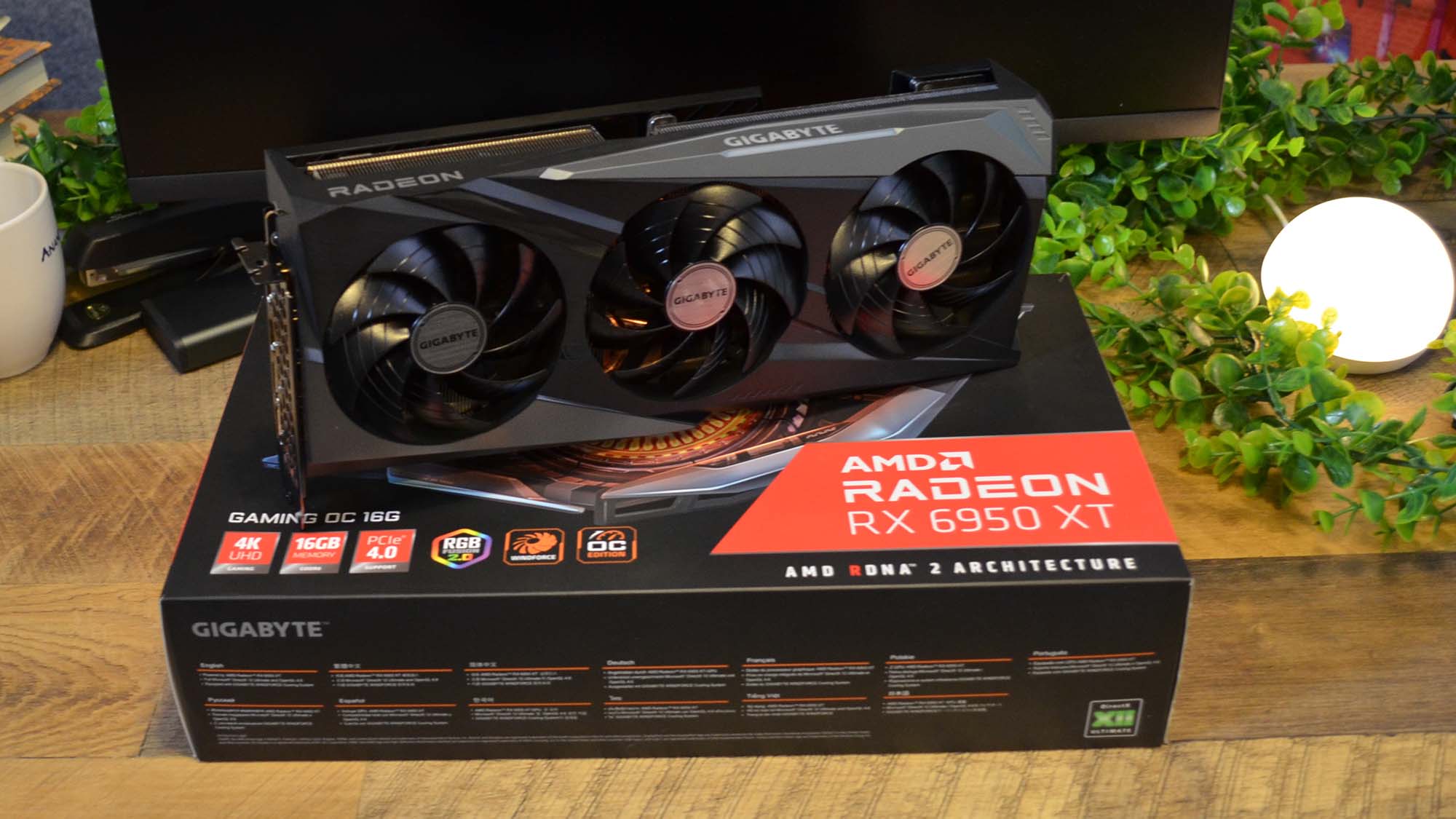
Buy it if…
Don’t buy it if…
Also consider
| Value | For a premium graphics card, the gaming performance you are getting for the price is fantastic, but better cards at the same price or lower might be just a few months away. | 4/5 |
| Design | The Gigabyte Gaming OC design is definitely a step up from the AMD reference card design, but it's also not a stunning showpiece. | 3.5/5 |
| Performance | Gaming performance is fantastic, especially for rasterized, non-ray-traced graphics, but it struggles with creative workloads. | 4/5 |
First reviewed in June 2022
0 comments:
Post a Comment